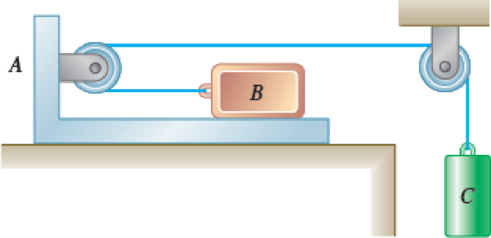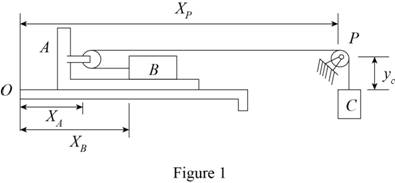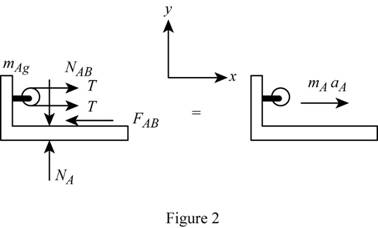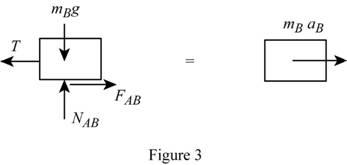
A 10-lb block B rests as shown on a 20-lb bracket A. The coefficients of friction are μs = 0.30 and μk = 0.25 between block B and bracket A, and there is no friction in the pulley or between the bracket and the horizontal surface. (a) Determine the maximum weight of block C if block B is not to slide on bracket A. (b) If the weight of block C is 10 percent larger than the answer found in a, determine the accelerations of A, B, and C.
Fig. P12.31

(a)
Find the maximum weight of block C if block B is not to slide on bracket A.
Answer to Problem 12.31P
The maximum weight of block C if block B is not to slide on bracket A is
Explanation of Solution
Given information:
The weight of block B
The weight of bracket A
The coefficient of static friction between block B and bracket A
The coefficient of kinetic friction between block B and bracket A
Calculation:
Let as consider the horizontal coordinate of A is
left of A.
Let as consider the horizontal coordinate of B is
left of A.
Let as consider
Sketch the system with coordinates points as shown in Figure (1).

Write the general equation of mass (m):
Here, W is the weight, g is the acceleration due to gravity.
Consider the constraint of cord.
Write the total length of cable length (L).
Here,
Differentiate Equation (1) with respect to t to write velocity of the blocks.
Here,
Differentiate Equation (2) with respect to t to write acceleration of the blocks.
Here,
No slip between bracket A and block B. Therefore, the acceleration of bracket A is equal to acceleration of block B.
Substitute
From Equation (4) and (5), consider
Sketch the free body diagram and kinetic diagram of bracket A as shown in Figure (2).

Refer Figure (2).
Apply Newton’s law of equation along x-axis.
Here, T is the tension in the cable,
Substitute
Here,
Sketch the free body diagram and kinetic diagram of block B as shown in Figure (3).

Refer Figure (3).
Apply Newton’s law of equation along x-axis.
Substitute
Here,
Apply Newton’s law of equation along y-axis.
Here,
Write the equation of frictional force
Substitute
Sketch the free body diagram and kinetic diagram of block C as shown in Figure (4).

Refer Figure (4).
Apply Newton’s law of equation along y-axis.
Substitute
Here,
Adding Equation (5), (6), and (9).
Substitute Equation (6) in Equation (12).
Subtract Equation (6) and (9).
Substitute Equation (6) and (10) in Equation (14).
Subtracting Equation (13) and (9).
Substitute 0.30 for
Thus, the maximum weight of block C if block B is not to slide on bracket A is
(b)
Find the accelerations of bracket A, block B and block C.
Answer to Problem 12.31P
The accelerations of bracket A is
The accelerations of block B is
The accelerations of block C is
Explanation of Solution
Given information:
The weight of block C is 10 % larger than the answer found in part (a).
Calculation:
Find the weight of block C.
The slip is occurring. Therefore consider the kinetic acceleration.
Write the equation of frictional force
Substitute
Subtract Equation (6) and (9).
Substitute Equation (17) in Equation (18).
Substitute 0.25 for
Rewrite the Equation (5).
Substitute 10 lb for
Find the accelerations of bracket A, block B and block C.
Solve Equation (3), (20), and (21).
Thus, the accelerations of bracket A is
Thus, the accelerations of block B is
Thus, the accelerations of block C is
Want to see more full solutions like this?
Chapter 12 Solutions
Vector Mechanics for Engineers: Statics and Dynamics
Additional Engineering Textbook Solutions
HEAT+MASS TRANSFER:FUND.+APPL.
Fox and McDonald's Introduction to Fluid Mechanics
Thinking Like an Engineer: An Active Learning Approach (3rd Edition)
Fundamentals of Aerodynamics
Statics and Mechanics of Materials
Thermodynamics: An Engineering Approach
- A cable is placed around three parallel pipes. Two of the pipes are fixed and do not rotate; the third pipe is slowly rotated. Knowing that the coefficients of friction are μs= 0.25 and μk= 0.20, determine the largest weight W that can be raised (a) if only pipe A is rotated counterclockwise, (b) if only pipe C is rotated clockwise.arrow_forwardBlocks A, B, and C have weights of 50 N, 25 N, and 15 N, respectively. Determine the smallest horizontal force P that will cause impending motion. The coefficient of static friction between A and B is μs = 0.3, between B and C,μ's = 0.4, and between block C and the ground, μ"s = 0.35.arrow_forwardA system of blocks is pulled by a force P. The string connecting blocks A and B passes over apulley whose coefficient of friction between string and pulley is 0.25. The coefficient of frictionbetween surface and blocks is 0.20. Block A weighs 200N and block B weighs 300N. Determine,a. the minimum value of P for impending motion to the right.b. the tension connecting block B.arrow_forward
- A tractor-trailer rig with a 2000-kg tractor, a 4500-kg trailer, and a 3600-kg trailer is traveling on a level road at 90 km/h. The brakes on the rear trailer fail, and the antiskid system of the tractor and front trailer provide the largest possible force that will not cause the wheels to slide. Knowing that the coefficient of static friction is 0.75, determine (a) the shortest time for the rig to a come to a stop, (b) the force in the coupling between the two trailers during that time. Assume that the force exerted by the coupling on each of the two trailers is horizontal.arrow_forward2.5 kg block is initially at rest on a horizontal surface. A horizontal force of magnitude 5.8 N and a vertical force are then applied to the block. The coefficients of friction for the block and surface are ?s = 0.38 and ?k = 0.23. (a) Determine the magnitude of the frictional force acting on the block if the magnitude of is 8.0 N. N(b) Determine the magnitude of the frictional force acting on the block if the magnitude of is 10.0 N. N(c) Determine the magnitude of the frictional force acting on the block if the magnitude of is 12.0 N. Narrow_forward(a) Draw the FBD of wedge B and block A when wedge B impends to slide to the right. Friction is negligible except for the contact surfaces between B and the horizontal plane B whose coefficient of friction is 0.20. (b) Determine P to impend the wedge B to slide to the right.arrow_forward
- Baggage on the floor of the baggage car of a high-speed train is not prevented from moving other than by friction. The train is traveling down a 5-percent grade when it decreases its speed at a constant rate from 120 mi/h to 60 mi/h in a time interval of 12 s. Determine the smallest allowable value of the coefficient of static friction between a trunk and the floor of the baggage car if the trunk is not to slide.arrow_forwardthe system blocks shown below is in equilibrium, the weight of block A is 10 kN and for block B is 35 kN . The coefficient of friction between A and surface is 0.2 and between two block A and B is 0.15. Answer the following: The direction of friction force between two blocks which effect on block A is in * First Quarter Second Quarter Third Quarter Fourth Quarter The value of friction force between two blocks is * 5.6 kN 6.4 kN 4.8 kN Non above-mentioned The value of friction force between block A and its surface is * 4.0 kN 5.5 kN 6.2 kN Non above-mentioned The coefficient of friction between block B and surface is * 5 نقاط 0.24 0.63 0.56 0.37 The value of friction force between the block B and it's surface is * 25 kN 35 kN 15 kN Non above-mentioned The system is in * Equilibrium Impending to motion Kinematicarrow_forwardA baggage conveyor is used to unload luggage from an airplane. The 10-kg duffel bag A is sitting on top of the 20-kg suitcase B . The conveyor is moving the bags down at a constant speed of 0.5 m/s when the belt suddenly stops. Knowing that the coefficient of friction between the belt and B is 0.3 and that bag A does not slip on suitcase B, determine the smallest allowable coefficient of static friction between the bags.arrow_forward
- A block with a mass of 100 kg (left-block) is connected to another block of mass M (right-block) by a cable that passes over a fixed drum as shown below. The coefficient of static friction between the left-block and the floor is 0.45, between the right-block and floor is 0.4, and between the cable and the fixed drum is 0.25. Ignore tipping (overturning). Determine the minimum mass of the left-block for which motion does not occur.arrow_forwardA block weighing 2.50 kg begins its motion from a stationary position at point A, located at the highest point of a frictionless ramp. The ramp is inclined at an angle of 40° relative to the horizontal and has a length of 1.50 m. As the block slides down the ramp, it reaches a region between point B and point C, which is a rough horizontal surface with a kinetic friction coefficient of 0.30. After covering a distance of 1.00 m on the horizontal surface, the block encounters a lightweight spring with a spring constant of 900 N/m. A. Find the total energy for point A and point B? B. Find the speed of the block at point B? C. What is the cumulative work performed on the block as it moves along the rough horizontal surface? D. By employing the work-energy theorem, determine the velocity of the block at point C just before it collides with the spring?arrow_forwardIn the system shown two blocks A and B are joined by anegligible ground cable passing through a fixed pulley that does notbroken. Block A has a mass of 45 kg and the coefficients ofstatic friction are 0.40 between rope and pulley and 0.30 betweenblocks and inclined planes. Determine: a) The maximum mass of block B that will cause theblock A slides down.b) The minimum mass of block B that will cause block A to slide up.c) Explain the condition of the system if the mass of block B were 80 kg.arrow_forward
 International Edition---engineering Mechanics: St...Mechanical EngineeringISBN:9781305501607Author:Andrew Pytel And Jaan KiusalaasPublisher:CENGAGE L
International Edition---engineering Mechanics: St...Mechanical EngineeringISBN:9781305501607Author:Andrew Pytel And Jaan KiusalaasPublisher:CENGAGE L
